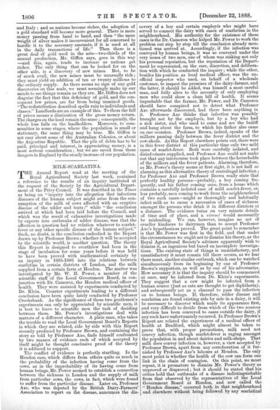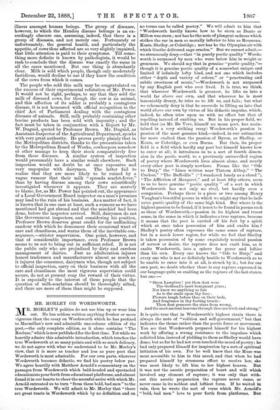MILK-SCARLATINA. T HE Annual Report read at the meeting of the
Royal Agricultural Society last week, contained a reference to the results of an inquiry instituted at the request of the Society by the Agricultural Depart- ment of the Privy Council. It was described in the Times as being an "inquiry into the allegation that infectious diseases of the human subject might arise from the con- sumption of the milk of cows affected with an eruptive disease of the udder and teats ;" while "the conclusion arrived at which had been laid before the Council, and. which was the result of exhaustive investigations made by experts into outbreaks of udder disease, was that the affection in question had no relation whatever to scarlet- fever or any other specific disease of the human subject." Such, no doubt, is the conclusion embodied in the Report drawn up by Professor Brown ; whether it will be accepted by the scientific world, is another question. The theory this Report is designed to overthrow had. been in the stage of incubation for some years before it was held to have been proved with mathematical certainty by an inquiry in 1885-1886 into the relations between scarlatina in certain districts of London, and the milk- supplied from a certain farm at Hendon. The matter was investigated by Mr. W. H. Power, a member of the scientific staff of the Local Government Board, in con- junction with Dr. Cameron, the Hendon medical officer of health. They were assisted by experiments conducted by Dr. Klein. Counter experiments leading to a different conclusion have been quite lately conducted by Professor Crookshank. As the significance of these two gentlemen's experiments can only be appreciated by scientific men, it is best to leave to scientific men the task of deciding between them. Mr. Power's investigations deal with matters of a different character. A plain man, who takes the trouble to read the Local Government Board's Reports in which they are related, side by side with this Report recently produced by Professor Brown, and containing the story as told by Professor Axe, finds himself confronted by two masses of evidence each of which accepted by itself might be thought conclusive proof of the theory it is adduced to support. The conflict of evidence is perfectly startling. In the Hendon case, which differs from others quite as much in the probability of the infection having come from the cows, as in the improbability of its having come from human beings, Mr. Power seemed to establish a connection between the sickness in London and the supply of milk from particular cows, the cows, in fact, which were found. to suffer from the particular disease. Later on, Professor Axe, who was deputed by the British Dairy-Farmers' Association to report on the disease, announces the dis- covery of a boy and certain employes who might have served to connect the dairy with cases of scarlatina in the neighbourhood. His authority for the existence of these cases is the Dr. Cameron who helped Mr. Power to work the problem out step by step till the conclusion already men- tioned was arrived at. Accordingly, if the infection was conveyed by human beings, it was so conveyed under the very noses of two men, one of whom was staking not only his personal reputation, but the reputation of the Depart- ment he represented, on the care, discretion, and delibera- tion with which he conducted the inquiry ; while the other, besides his position as local medical officer, was the un- official inspector who used, on behalf of a wholesale customer, to inspect the premises of the dairy-farmer, and. the latter, it should be added, was himself a most careful man, and fully alive to the necessity of only employing men who could show a clean bill of health. It seems improbable that the farmer, Mr. Power, and Dr. Cameron should have conspired not to detect what Professor Axe afterwards discovered, had there been anything in it. Professor Axe thinks that infection was possibly brought not by the employes, but by a boy who had a sick sister, and who used. to come and see the bailiff and hang about the farm, to which his father also came on one occasion. Professor Brown, indeed, speaks of the milkers passing daily between the fever district and the cow-sheds. As this Report elsewhere points out, there were in this fever district at this particular time only two mild. cases of scarlet-fever. Both were carefully isolated, and disinfectants supplied, and Professor Axe could not make out that any intercourse took place between the households of the milkers and the fever patients Alarming, therefore, as Mr. Power's theory seems at first sight, it is not half so alarming as this alternative theory of centrifugal infection ; for Professor Axe and. Professor Brown really state that perfectly healthy persons—probably, a boy coming fre- quently, and his father coining once, from a house which contains a carefully isolated case of mild. scarlet-fever, or, less probably, men coming to work from the neighbourhood of two such cases—might so thoroughly and habitually infect milk as to cause a succession of cases of sickness amongst the persons who drink it in different districts at a distance. The evidence turns on very minute details of time and of place, and a resume would, necessarily be misleading. We can, however, imagine no act of crueller kindness to dairymen than to accept Professor Axe's hypothesis as proved. The great point to remember is that Mr. Power was first in the field, and. that under the circumstances we ought not to dismiss his theory, as the Royal Agricultural Society's advisers apparently wish to dismiss it, as ingenious but based. on incomplete investiga- tions. The existing state of things is unsatisfactory, and unsatisfactory it must remain till there occurs, as we fear there must, another similar outbreak, which can be watched simultaneously from its beginning by one of Professor Brown's supporters, as well as by one of his adversaries. How necessary it is that the inquiry should. be commenced. at once, may be inferred from Dr. Klein's experiments. They suggest that a cow might be infected from a human source (just as cats are thought to get diphtheria), and subsequently act as a channel to pass the infection on to human beings. If, therefore, udder disease and scarlatina are found existing side by side in a dairy, it will be necessary to discover which made its appearance first, and very difficult to decide from which of the two sources infection has been conveyed to cases outside the dairy, if any such have unfortunately occurred. In Professor Brown's Report are related the experiences of a medical officer of health at Bradford, which might almost be taken to prove that, with proper precautions, milk need not convey infection, though scarlet-fever is raging amongst the population in and about dairies and milk-shops. That milk does convey infection is, however, a view accepted by Professor Brown, apart from any corroboration of it fur- nished by Professor Axe's labours at Hendon. The only moot point is whether the health of the cow can form one link in the chain of contagion. On this point, we must repeat, it is premature to dismiss Mr. Power's theory as unproved or disproved ; but it should be stated that his critics hold that outbreaks of a disease indistinguishable from that observed by the representatives of the Local Government Board at Hendon, and now called. the "Hendon disease," occurred. both in that neighbourhood and elsewhere without being followed by any scarlatinal illness amongst human beings. The group of diseases, however, to which the Hendon disease belongs is an ex- ceedingly obscure one, assuming, indeed, that there is a group of diseases, and not merely one. Fortunately or unfortunately, the general health, and particularly the appetite, of cows thus affected are so very slightly impaired, that little attention is paid to their symptoms. Till some- thing more definite is known by pathologists, it would, be rash to conclude that the disease was exactly the same in all the cases mentioned. But one thing is abundantly clear. Milk is sold which people, though only moderately fastidious, would decline to use if they knew the condition of the cows from which it comes.
The people who sold this milk may be congratulated on the success of their experimental refutation of Mr. Power. It would not be right, perhaps, to say that they sold the milk of diseased cows, for though the cow is an animal, and this affection of its udder is probably a contagious disease, it is not honoured with official recognition in the chief Act of Parliament dealing with the contagious diseases of animals. Still, milk probably containing other bovine products has been sold with impunity ; and the fact must be taken in conjunction with a Report by Mr. W. Duguid, quoted by Professor Brown. Mr. Duguid, as Assistant-Inspector of the Agricultural Department, speaks with very great authority. He proves pretty plainly that in the Metropolitan districts, thanks to the precautions taken by the Metropolitan Board of Works, cowkeepers somehow or other manage to keep their stock comparatively free from these diseases. A similar system of inspection would presumably have a similar result elsewhere. Such inspection would no doubt be at once expensive and very unpopular with dairymen. The latter fail to realise that they are more likely to be ruined by a vague rumour that their milk "spreads scarlet-fever," than by having disease among their cows scientifically investigated whenever it appears. They are scarcely to blame, for, as Mr. Power has pointed out, the appearance of a Local Government Board inspector on a man's premises may lead to the ruin of his business. As a matter of fact, it is known that in one case at least, such a rumour as we have mentioned had got abroad and that the mischief had been done, before the inspector arrived. Still, dairymen do not like Government inspectors, and considering his position, Professor Brown deserves great credit for the unflinching candour with which he denounces their occasional want of care and cleanliness, and warns them of the inevitable con- sequence,--stricter supervision. One point, however, and that of considerable importance, even Professor Brown seems to us not to bring out in sufficient relief. It is not the public only who are prejudiced by dirty and careless management of dairies. Just as adulteration injures honest tradesmen and manufacturers almost as much as it injures the consumer, dairymen who, though not subject to official inspection, carry on their business with all the care and cleanliness the most rigorous supervision could secure, do not at present reap the reward of their virtue. It is especially to the interest of these people that the question of milk-scarlatina should be thoroughly sifted, and there are more of them than might be supposed.











































 Previous page
Previous page